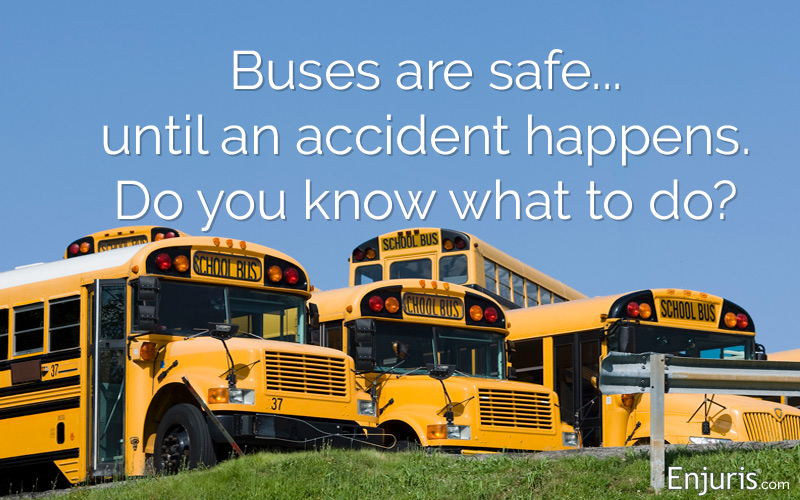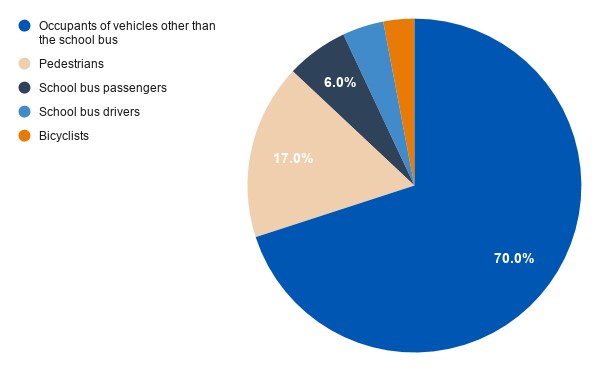Different types of buses have different legal outcomes if you’re in an accident. Know what to do, what your time frame must be, and who can help.
When a bus is involved in an accident, it’s usually big news.
The main reason is that there’s the potential for a lot of people to be injured, and because bus accidents are fairly uncommon.
An estimated 5.3% of Californians commute to work by public transit, which is more than 2 million people based on California’s population of over 39.5 million. About 65.2% of people in this group use buses to commute to work. The other 34% of commuters ride heavy, light, or commuter rail systems, or other public transportation.1
And that’s just adults.
About 1 in 8 students take a bus to school in California. That adds up to about 700,000 students, or 12%.2 In fact, California has the largest mass transportation system for schools in the country. There are more than 25,000 school buses in the state that provide about 3 million passenger rides each day. During the course of a year, California school buses travel more than 334 million miles and provide over a half billion passenger rides.3
Commuting and school aren’t the only reasons to take a bus. Many people use bus companies like Greyhound, Megabus, and Flixbus to travel throughout the state.
It’s inevitable that with so many buses on the road each day — between commuters, schoolchildren, tourists, and other bus riders — accidents are bound to happen.
Types of California bus accidents
Most buses are included in one of the following categories:
- Public transportation (commuting)
- Private bus lines (Greyhound, Megabus, Flixbus, etc.)
- School buses
- Airport or hotel shuttles
- Private charter buses
- Tour buses
Some bus accidents involve crashes with stationary objects or other vehicles. People can also be hurt getting on or off the bus, or by another driver that ignores the fact that the bus is stopped.
Although crashes can happen in a variety of ways, these are common causes of bus accidents:
- Distracted driving
- Poor driver training, negligence, or fatigue
- Location with heavy population and too-small space for maneuvering
- Weather-related accidents
- Lack of passenger protection (for example, seat belts)
- Vehicle structure (size, shape, etc.)
- Road conditions and construction
- Vehicle defects or handling problems
- Weight distribution within the vehicle
- Blind spots
- Driver error or speeding
Examples of notorious bus accidents in California
A tour bus collided with a truck and sedan around 6:30 p.m. as it followed California Route 38 leading from the Big Bear area.
The charter bus was carrying 38 passengers, some of whom were children. The driver lost control of the vehicle as it was driving down the mountain, and the bus rolled over the truck, causing it to be crushed. The truck driver survived.
It took firefighters more than 2 hours to extricate the injured passengers, and 27 were sent to area hospitals. Ultimately, 8 people were killed in the crash and more than 30 were injured.
Gospel singer Josh Turner’s road crew was traveling by bus on Highway 46, about 78 miles north of Santa Maria, when the bus they were riding in crashed following a concert at Vina Robles Amphitheater in Paso Robles. The singer wasn’t on the bus at the time of the accident.
The bus veered off the road, drove 20 yards through vegetation, and hit a riverbed after it launched off an 80-foot cliff. One passenger died and 7 were injured.
A tour bus collided with the rear of a tractor trailer, resulting in the deaths of the bus driver and 12 passengers, and leaving dozens with injuries.
The bus had left the Red Earth Casino and was returning to Los Angeles at the time of the crash. The vehicle had passed recent inspections and showed no mechanical problems. However, the bus was traveling faster than the tractor trailer and the driver didn’t stop in time to avoid a crash.
Bus accident prevention laws
We all want safer roads and fewer accidents.
In 2012, Congress enacted the Motorcoach Enhanced Safety Act, which requires new buses to include enhanced safety features like seat belts and harnesses, reinforced windows, crush-resistant roofs, enhanced driver training, and flame-resistant bus interiors.
This federal law followed an Atlanta bus crash that killed several members of an Ohio university baseball team.
School bus accidents
If you’re a parent who puts your child on a school bus each morning, the prospect of a school bus crash is likely one of the scariest things you can imagine.
However, school buses remain one of the safest forms of transportation. One reason school buses are safer than cars or other buses is because they’re built for compartmentalization. Compartmentalization is the “protective envelope created by strong, closely-spaced seats that have energy-absorbing high seat backs that protect occupants in the event of a crash.”6
Currently, school buses are required to be equipped with a lap belt for each passenger, but the Department of Transportation is considering a proposal to require lap and shoulder belts that fit passengers from age 6 to adult.
Bus accident liability in California
For the most part, a bus accident is handled just like any California personal injury claim. If you were a bus passenger injured in an accident caused by another driver, you’d file a claim against the driver’s insurance. If you were a bus driver injured by another driver, you’d file a workers’ compensation claim with your employer.
But what if the bus driver caused the accident?
Things get a little more complex if that’s what happened. First, it depends on who owns and operates the bus.
- Private or charter bus: If the bus is privately owned (or owned by a bus company), it’s required to have specific types of insurance. You might have a claim against the driver, the company, or another party altogether (like the bus manufacturer, if the accident was the result of an equipment failure).
- Government-owned bus: This applies to a city bus, which is likely what you’re riding if you commute. A school district is also a government entity.
The California Tort Claims Act (CTCA) requires that an injured person must provide notice of a claim to the responsible agency within 6 months. The agency can accept the claim or reject it. If it rejects your claim, you could then file a lawsuit.
You can file a claim under the CTCA for:
- Negligent acts by employees (which could include the bus driver)
- Negligent acts by independent contractors (which could also include the bus driver)
- Premises liability for a dangerous condition on government property
- Damages caused by the public entity’s failure to carry out a duty imposed by law
How to file a notice of claim in California
A notice of claim is similar to a demand letter.
Your notice of claim must include the following:
- Your name and mailing address
- The postal address where you would like mail to be sent
- The date, location, and other circumstances of the accident
- A general description of the injury, damage, or loss
- The name of public employee (or employees) who caused your injury
- The amount claimed if the total is less than $10,000 when the notice of claim is presented. It must also include the estimated amount for any anticipated injury, damage, or loss in addition to losses already experienced. If the claim is for more than $10,000, don’t include a dollar amount.
- The claim would need to indicate whether it would be a limited civil case. (A limited civil case is when the plaintiff claims more than $10,000 but less than $25,000 and meets other conditions.)
If you fail to include the required information in a notice of claim, you could lose your right to file a claim.
A claim against the government in California must be filed within 6 months for a personal injury, wrongful death, or damage to personal property.
There are some exceptions that permit late claims, such as if the claimant has died, is under the age of 18 for the 6-month period, or had mental or physical incapacity.
After your claim is filed, the government agency has 45 days to respond. The agency can:
- Accept or reject the claim, or offer a compromise as a settlement.
- Indicate that the claim doesn’t have sufficient information. You would then have a specific time period to amend the claim.
- Return the claim if it didn’t meet the 6-month statute of limitations.
If the government agency doesn’t respond within 45 days, the claim is rejected.
If your claim was rejected, you have 6 months to petition the court to file a lawsuit. If the rejection is because the government agency failed to respond, you may file a petition within 2 years. If the court accepts your petition, you have 30 days to file a lawsuit.
Private or charter bus liability
If you’re involved in an accident with a private or charter bus, either as a passenger or as the driver of another vehicle, you’ll want to know who owns the bus and was responsible for its operation.
You can file a claim against the owner or operator of the bus company, perhaps the driver, or even the manufacturer of the bus if the accident was the result of an equipment failure.
The California Public Utilities Commission has regulatory and safety oversight over private and charter buses (in other words, for-hire passenger carriers). A California personal injury lawyer can help determine liability based on whether the rules and regulations were being followed and if negligence was a factor.
Damages awarded in California bus accident claims
As with any accident, your injuries from a California bus accident can range from mild to severe. You likely won’t receive a damage award for injuries like minor cuts or bruises if you didn’t receive medical treatment.
If you’re severely injured, you can receive damages for:
- Medical treatment (including hospital stays, doctor visits, assistive devices, surgeries, etc.)
- Ongoing therapies
- Emotional distress (pain and suffering)
- Lost wages from time off of work and future earning capacity
- Any other costs you incurred as a result of the accident
What to do after a California bus accident
A bus accident isn’t as straightforward as a regular car accident. You might have several liable parties, and you could be dealing with large companies or government agencies.
A personal injury lawyer is the best, most well-informed person to help you navigate the complicated legal landscape if you need to file a claim against the government. Governments operate on tight budgets and don’t want to pay out claims unless they have no way out — but you deserve to be compensated for your losses if the accident was the fault of the driver or if the bus equipment was defective.
Regardless of how the accident happened, your lawyer will gather the evidence, request records, and investigate the claim in order to get what you need to move forward. You can start with the Enjuris Personal Injury Law Firm Directory to find a California lawyer who will help you pursue a claim following a bus accident.
Sources:
1 California Energy Commission, Public Transit in California
2 California Legislative Analyst’s Office, Review of School Transportation in California
3 San Diego Unified School District Transportation Department, Statistics of the Yellow School Bus
4 Journalist’s Resource, Bus Crashes in the United States: What Does the Research Say?
5 National Highway Traffic Safety Administration, Crash Facts
6 California Department of Education, NHTSA’s Unedited Summary of School Bus Report
See our guide Choosing a personal injury attorney.


